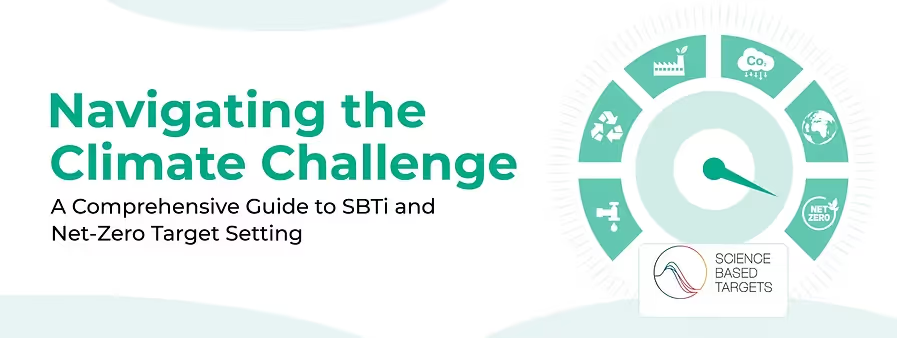The Science-Based Targets initiative (SBTi) is a collaborative effort between CDP (formerly the Carbon Disclosure Project), the United Nations Global Compact, the World Resources Institute (WRI), and the World Wildlife Fund (WWF). SBTi aims to assist companies in setting science-based emission reduction targets, aligning their efforts with the global goal of limiting global warming to well below 2 degrees Celsius above pre-industrial levels.
SBTi follows a rigorous and science-driven approach, requiring companies to set emission reduction targets based on scientific criteria rather than arbitrary figures. This ensures that the targets are in line with what the latest climate science deems necessary to prevent catastrophic climate change.
Key Components of SBTi
Scope 1, 2, and 3 Emissions: SBTi takes into account the three scopes of emissions. Scope 1 includes direct emissions from owned or controlled sources, Scope 2 covers indirect emissions from the generation of purchased energy, and Scope 3 encompasses indirect emissions throughout the value chain.
- Target Setting Criteria: To be recognized by SBTi, companies must set targets that align with limiting global warming to either 1.5 degree Celsius. These targets should be consistent with the sector-specific decarbonization pathways provided by SBTi.
- Decarbonization Pathways: SBTi provides companies with sector-specific decarbonization pathways, which outline the trajectory for reducing emissions to meet the 1.5 degree Celsius target. These pathways serve as a valuable guide for businesses seeking to align their practices with the latest scientific recommendations.
- Validation and Verification: Companies that commit to SBTi must undergo a thorough validation process to ensure their targets are in accordance with the initiative's criteria. This process involves an assessment of the target's feasibility and credibility. Subsequently, companies are required to undergo periodic verification to ensure ongoing adherence to their targets.
- Continuous Improvement: SBTi encourages companies not only to set ambitious targets but also to pursue continuous improvement in their emissions reduction strategies. This iterative approach ensures that companies stay aligned with the latest advancements in climate science and maintain a proactive stance in combating climate change.
Setting the Stage for Net-Zero
As the urgency of addressing climate change intensifies, the Net-Zero target has emerged as a paramount commitment for organizations worldwide. A Net-Zero target signifies achieving a balance between the amount of greenhouse gas emissions produced and the amount removed from the atmosphere. This balance is often achieved through a combination of emission reductions and investments in carbon removal technologies.
Key Elements of Net-Zero Target Setting
- Ambitious Timelines: Companies setting Net-Zero targets commit to achieving carbon neutrality within a specific timeframe. Common deadlines include 2030, 2040, or 2050, aligning with global efforts to reach net-zero emissions by mid-century.
- Comprehensive Scope Coverage: Net-Zero targets go beyond Scopes 1 and 2 emissions, encompassing the entirety of Scope 3 emissions as well. This comprehensive approach ensures that companies address their entire value chain, including suppliers, customers, and other stakeholders.
- Carbon Offsetting and Removal: Achieving Net-Zero often involves investing in carbon offset projects and removal technologies. This can include initiatives such as reforestation, afforestation, carbon capture and storage (CCS), and direct air capture (DAC).
- Transparency and Reporting: Companies committing to Net-Zero are expected to maintain transparency in their efforts. Regular reporting on progress, challenges, and achievements enhances accountability and fosters trust among stakeholders.
SBTi and Net-Zero: A Synergistic Approach
The integration of SBTi and Net-Zero target setting represents a powerful strategy for companies aiming to make a meaningful impact on climate change. By aligning with SBTi, businesses establish a scientifically grounded foundation for their emission reduction efforts. Subsequently, adopting a Net-Zero target provides a clear roadmap for achieving carbon neutrality within a specified timeframe.
The Benefits of SBTi and Net-Zero Target Setting for Businesses
- Risk Mitigation: By aligning with SBTi and adopting Net-Zero targets, businesses position themselves to mitigate climate-related risks. This proactive approach helps safeguard against regulatory changes, market shifts, and physical impacts associated with climate change.
- Competitive Advantage: Companies that commit to SBTi and Net-Zero targets gain a competitive edge in the market. Increasingly, consumers and investors are prioritizing sustainability, and organizations with robust environmental commitments are more likely to attract support.
- Innovation and Resilience: Pursuing science-based and Net-Zero targets drives innovation within companies. The need to find sustainable solutions often leads to the development of new technologies, processes, and business models, enhancing the overall resilience of the organization.
- Stakeholder Engagement: SBTi and Net-Zero commitments enhance stakeholder engagement by demonstrating a company's dedication to environmental responsibility. This can foster positive relationships with customers, employees, investors, and communities.
StepChange empowers organizations to chart a clear path towards setting and achieving ambitious yet achievable net-zero goals, specifically aligned with the Science Based Targets initiative (SBTi). StepChange’s ESG Software will guide you through every step:
- Measure and Analyze: Gain deep insights into your environmental footprint across Scopes 1, 2, and 3 emissions with robust measurement tools. This detailed picture serves as the foundation for informed goal setting.
- Set Ambitious Targets: Leverage StepChange's team of climate scientists to define science-based net-zero targets that comply with SBTi's rigorous criteria. This will ensure that your goals are ambitious yet achievable, considering your industry, size, and current emissions profile.
- Develop Actionable Strategies: Translate your goals into concrete action plans. StepChange helps you identify and prioritize impactful emission reduction initiatives across your operations, supply chain, and product portfolio.
- Track Progress and Refine: Continuously monitor your progress towards your net-zero targets using StepChange's advanced reporting tools. This data-driven approach allows you to identify areas for improvement and refine your strategies for maximum impact.
By partnering with StepChange, you gain access to not only the software but also their team of sustainability experts and climate scientists. Get in touch to schedule a demo session today.




.svg)